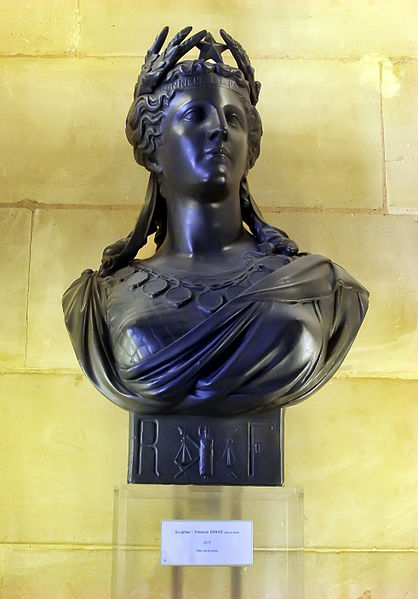Marianne - the symbol of the State of France
Yesterday I published an image of Le Coq on top of the church in Lénault. Le Coq has long been the unofficial symbol of France, adopted by its national sports teams. However the OFFICIAL symbol of the Republic of France is in fact Marianne whose image appears on many coins, stamps and all government paperwork. If you are unlucky enough to get a French tax bill it will be Marianne you'll see on the letter head.

So who was Marianne and why is she the symbol of the Republic France? For this I must thank a French friend who wrote the following piece explaining the history of the lady who now represents Liberté, Egalité and Fraternité. Below is my translation of her piece with the original, in French, after that.
Why is the symbol of the Republic called Marianne?
Why a woman?
Because the word republic in French is a feminine noun - La République.
Why the name "Marianne"?
This seems to be from the contraction of Marie and Anne, two first names that were very widespread in the eighteenth century among the female population. Marianne embodies the values of the republic and the people of France: "Liberty, equality, fraternity". It symbolises the "motherland", the nurse, the protector, the warrior!

Liberty Leading the People by Eugène Delacroix (1798–1863)
Even though the 1958 Constitution has taken the tricolour as France's National Emblem, Marianne still represents the French Republic. Marianne is shown wearing a phrygian cap, typically worn at the time of The French Revolution and an emblem of freedom and of the Republic. The phrygian cap was ealier worn by freed slaves in Greece and Rome as a symbol of their freedom. This type of cap was also worn by sailors and galley-slaves in the Mediterranean and would have been taken back by the revolutionaries to the south.
Under the third Republic (from 1870) the number of statues and busts of Marianne multiplied, particularly in the town halls. Several different representations developed according to what she was to emphasise - the revolutionary character or the "wise" character of Marianne. In some cases the phrygian cap was considered too revolutionary and has been replaced by a tiara or a crown of laurels.

Bust of Marianne wearing a laurel crown by Théodore Doriot and found in the French Senate
So Marianne never exisited as a real person and she was created to embody everything France stands for today summed up in those three words: Liberté, Egalité and Fraternité - Freedom, Equality and Fraternity.
Pourquoi le symbole de la République se nomme Marianne ?
Pourquoi une femme:
car le mot République est un nom féminin.
Pourquoi le prénom "Marianne" :
cela semble provenir de la contraction de Marie et Anne, deux prénoms très répandus au XVIIIe siècle parmi la population féminine.
Marianne incarne les valeurs de la République et du peuple français: "Liberté, Égalité, Fraternité". Elle symbolise la "mère patrie", la nourricière, la protectrice, la guerrière!
Même si la Constitution de 1958 a privilégié le drapeau tricolore comme emblème national, Marianne incarne aussi la République Française.
Les premières représentations d'une femme à bonnet phrygien, allégorie de la Liberté et de la République, apparaissent sous la Révolution française.
Symbole de liberté, le bonnet phrygien était porté par les esclaves affranchis en Grèce et à Rome. Un bonnet de ce type coiffait aussi les marins et les galériens de la Méditerranée et aurait été repris par les révolutionnaires venus du Midi.
Sous la IIIème République, les statues et surtout les bustes de Marianne se multiplient, en particulier dans les mairies.Plusieurs types de représentation se développent, selon que l'on privilégie le caractère révolutionnaire ou le caractère "sage" de la Marianne : le bonnet phrygien est parfois jugé trop séditieux et remplacé par un diadème ou une couronne.



